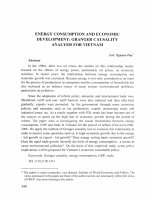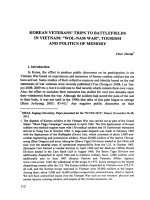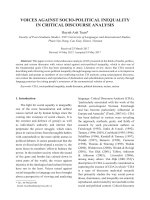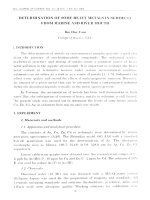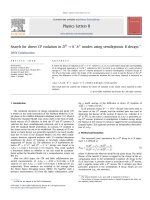DSpace at VNU: Green Growth Towards Sustainable Development in Vietnam
Bạn đang xem bản rút gọn của tài liệu. Xem và tải ngay bản đầy đủ của tài liệu tại đây (405.78 KB, 14 trang )
VNU Journal of Social Sciences and Humanities, Vol. 29, No. 4 (2013) 1-14
RESEARCH
Green Growth Towards Sustainable Development in Vietnam
Trần Thọ Đạt, Đinh Đức Trường*
National Economics University, Hanoi, Vietnam
Received 15 September 2013
Revised 20 October 2013; Accepted 15 December 2013
Abstract: Nowadays, growth model towards sustainable development widely recognized by
international community is green growth. However, the awareness, understanding and application
of green growth are still in process of formation for most countries. Promoting green growth in
Vietnam is not only suitable for the current economic integration process, but more importantly it
comes from the requirement of internal economy for growth model transformation. Vietnam, after
three decades of rapid growing is now facing several development issues such as low economic
growth quality, weak competitiveness, low efficiency, social inequality, natural resource depletion,
environmental pollution and climate change. In this context, green growth can be a potential
solution to these problems and helps Vietnam going towards sustainable development
This paper aims at analyzing basic dimensions of green growth in Vietnam by focusing on
following contents (i) development context in Vietnam; (ii) reasons for the selection of green
growth model in Vietnam; (iii) commitments and steps of Vietnam towards green growth; (iv)
opportunity and the challenge of Vietnam towards green growth model and (v) policy implications
for green growth in Vietnam. This paper uses the secondary data gathered from officially
international and domestic sources in Vietnam.
Economic growth is a critical goal of all nations. After more than two decades of embracing economic
reforms, Vietnam has now joined the group of medium income countries. The paper analyses the
relationship between green growth and quality of sustainable development in Vietnam.
This paper aims at analyzing basic dimensions of green growth in Vietnam by focusing on following
contents (i) development context and reasons for the selection of green growth model in Vietnam; (ii)
commitments and steps of Vietnam towards green growth; (iii) opportunities and challenges of Vietnam
towards green growth model and (v) policy implications for green growth in Vietnam. This paper uses
the secondary data gathered from officially international and domestic sources in Vietnam.
Keywords: Green growth, climate change, energy efficiency, sustainable development, Vietnam
Green Growth Strategy.
1. Introduction*
group of medium income countries. The
country has achieved many important United
Nations Millennium Development Goals on
poverty reduction and hunger eradication.
However, along with that growth is the
expansion of energy-intensive sectors such as
After more than two decades of embracing
economic reforms, Vietnam has now joined the
_______
*
Corresponding author. Tel: 84-916879768
E-mail:
1
2
T.T. Đạt, Đ.Đ. Trường / VNU Journal of Social Sciences and Humanities, Vol. 29, No. 4 (2013) 1-14
manufacturing,
transport
and
power
generation. Given the country’s dependence on
fossil fuels, Vietnam’s total greenhouse gas
emissions have more than doubled over the
past decade, and are expected to triple by 2030
[8]. Vietnam now has the 20th highest carbon
intensity in the world. Vietnam is also highly
exposed to the effects of climate change, in
particular to floods, storms, and sea-level
rises. Climate-related natural disasters result
in economic losses equivalent to 1.5 percent of
GDP, and these losses are expected to
increase. At the same time, the recent low
growth of total factor productivity has raised
questions about the quality and sustainability
of the country’s rapid economic growth [3].
Taken together, these factors have made
finding a more sustainable pathway to
development a top priority in Vietnam. In
2012, the government finalized a National
Green Growth Strategy that highlights the need
for emission reduction targets, industrial and
consumer energy efficiency, and ecosystem
restoration. Green growth is about making
growth process resource efficient, cleaner and
more resilient without slowing them down. It
also means making investment in the
environment to drive economic growth. Within
a Green Growth approach long term positive
synergies across the three dimensions are focal
point. Pursuing Green Growth will bring
opportunities for Vietnam not only to add
value to products and services, capture
international market, and develop clean
technologies but also reduce environmental
costs and to mitigate climate change impact. It
is a win- win approach- it makes sense, locally
and globally.
This paper aims at analyzing basic
dimensions of green growth in Vietnam by
focusing
on
following
contents
(i)
development context and reasons for the
selection of green growth model in Vietnam;
(ii) commitments and steps of Vietnam
towards green growth; (iii) opportunities and
the challenges of Vietnam towards green
growth model and (v) policy implications for
green growth in Vietnam. This paper uses the
secondary data gathered from officially
international and domestic sources in Vietnam.
2. Rationale for green growth in Vietnam
The quality of growth in Vietnam has
decreased in the last 5 years. First, there has
been a significant decrease in Vietnam’s total
productivity factor resulting from inefficient
use of capital and labor. Second, Vietnam’s
climate change vulnerability is among the
highest in the world and a significant increase
in CO2 emission is projected due to rising
energy demand. And finally, while Vietnam
has experienced a fall in monetary poverty, it
has also seen a rise in income and social
inequality.
These challenges are all warning on the
limitations of the current growth model. The
ability of Vietnam to address the quality of its
growth is at the core of its development
challenges. In the long run, a new model is
needed. A Green Growth approach, hence,
could be a vehicle for bringing quality at the
centre of policy discussion.
Economic dimension
Vietnam has achieved and impressive
growth over the last 20 years and has become a
middle
income
country.
Particularly
noteworthy is the average economic growth
rate of 7.5 percent per year during 1998-2008.
The country’s rapid growth has to a large
extent been based on a successful market
opening attracting foreign capital and an
abundance of low labor. These two elements
T.T. Đạt, Đ.Đ. Trường / VNU Journal of Social Sciences and Humanities, Vol. 29, No. 4 (2013) 1-14
account for more than 70% of the growth in
the last decade [8].
However, the added value within the
exporting sector remains low and productivity
in other parts of the economy is lagging far
3
behind. When comparing Vietnam to other
ASEAN countries, it is clear that Vietnam has
not used the capital inflow and labor force
efficiently using total factor productivity (TFP)
as an indicator.
Table 1: Total factor productivity contribution to growth 1990 - 2010
Period 1990 - 2000
Vietnam
China
India
Cambodia
Indonesia
Malaysia
Philippines
GDP
growth
rate
7.3
9.9
5.3
7.3
4.1
6.9
3.0
TFP
contributi
on
3.2
5.5
2.0
2.0
0.5
1.1
0.3
TFP
contributi
on share
44%
56%
38%
27%
12%
16%
10%
Period 2001 - 2010
GDP
growth
rate
7.3
9.7
7.3
9.0
5.1
5.4
4.7
TFP
contributi
on
1.9
5.0
2.7
1.3
2.5
2.7
1.8
TFP
contribution
share
26%
52%
37%
14%
49%
50%
38%
Development
in TFP
-18%
-4%
-1%
-13%
37%
34%
28%
Source: European Unions (2011)
In the same time, there has been a
significant increase of TFP contribution in
Indonesia, Malaysia and the Philippines. Both
China and India with the same or better growth
rates as Vietnam have managed almost to keep
the same level of TFP contribution. Within this
group, Vietnam stands out with a decrease of
18% in its TFP contribution compared to
1990’s. This can be seen in the current
macroeconomic imbalances like high inflation
as well as microcosmic bottlenecks like
qualified skilled labor shortages [3].
Environmental dimension
The economics growth model of Vietnam
is now challenged by serious environmental
issues including energy dependency and
inefficiency, increased level of carbon
emission and especially climate change.
Energy import dependency: There is a
general consensus among the Vietnamese
policy makers and planners that the domestic
energy resources of Vietnam are unlikely to be
able to meet the increasing energy demand of
the nation, which is driven by high growth rate
of the economy and population. Table 2
provides a summarized overview of primary
energy demand-supply balance for the period
1990-2025. With rapidly increasing energy
demand and limited domestic supply, Vietnam
is expected to become a net energy importer
within the next decade. It is projected that by
2025 the country will need import 48.6% of its
total commercial primary energy needs of
which coal, oil and gas are expected to account
for 18.8%, 23.4%, 5.1%, respectively, in the
total imported energy. At the same time,
electricity imports will also account for 1.3%
of total commercial primary energy
requirement [5]. This will lead to a substantial
change in the Vietnam’s energy structure.
Appropriate energy policies are therefore
needed to achieve a balance in the sources of
energy supply and to avoid energy supply
disruption caused by geopolitical disputes [6].
4
T.T. Đạt, Đ.Đ. Trường / VNU Journal of Social Sciences and Humanities, Vol. 29, No. 4 (2013) 1-14
Table 2: Energy balance in Vietnam during 1990 - 2025
Unit: MTOE
Type of energy
Commercial
Coal
Oil
Gas
Hydro
Nuclear
Renewable
Elec. Import
Noncommercial
Total
1990
Demand
5.4
2.2
2.7
0
0.5
0
0
0
18.9
24.3
Supply
5.8
2.6
2.7
0
0.5
0
0
0
18.9
24.7
2007
Demand
31.0
9.9
13.0
5.5
2.6
0
0
0
24.5
55.6
Supply
49.4
24.3
16.5
5.9
2.6
0
0
0
24.5
73.9
2025
Demand
135.4
64.2
43.7
16.3
6.8
2
1
2
10.6
146.0
Supply
88.7
45.0
19.9
16.2
5.4
2
0
0
18.6
107.3
Source: JICA (2008)
Energy efficiency: Low energy efficiency
(on the demand and supply sides) is another
major energy issue facing Vietnam. The major
sources of such inefficiency include: old
technologies and poor energy management
practices, from conversion to processing and
end-use levels. Indeed, only new, large-scale
combined-cycle natural gas-based power plants
incorporate world-class technology and provide
high fuel efficiency. Most existing coal and oilfired plants have low fuel efficiency as their
facilities and technology are relatively old (IE
2005). In 2005, energy losses in power
generation amounted to 9.5 % of total primary
energy consumption. The same
explanation
could be applied for the demand side where old
and high energy intensive technologies are
employed. Indeed, both primary and final energy
intensities of Vietnam are conspicuously higher
as compared with almost all ASEAN and OECD
countries. For example, in 2005, the country’s
primary energy intensity was 0.23 kgOE/$ while
ASEAN and OECD averages were 0.2 and 0.18
kgOE/$, respectively [6].
Carbon emission: Vietnam is currently one
of the lowest per capita emitters of carbon
emissions. In 2007, the country’s CO2
emissions per capita were 1.07 tons -
approximately 20% of the world average. At
the same time, however, CO2 emissions per
unit of GDP are very high - about 2 times the
world average. The CO2 emissions are
expected to grow rapidly as Vietnam
industrializes and the economy utilizes more
carbon intensive fuels, substituting traditional
non-commercial fuels including biomass. For
example, in the year 2025, fossil fuels will
account for nearly 93 of total commercial,
primary energy consumption, of which coal
will have a 47% share. Such a significant
reliance on fossil fuels, coal in particular,
could
have
serious
environmental
consequences. On average, the CO2 emissions
are projected to increase at an annual rate of
8.5% and could reach 400 millions tons by
2025. Also, SO2 emissions - a key contributor
to Acid Rain - are likely to increase from
0.34mn tons currently, to 1.14mn tons by 2025
[5]. Major sources for such emissions are
energy, industry and transport sectors,
accounting for more than 85% of total CO2
emissions. Therefore, environmental issues
will need to be taken into consideration in
making plans for economic and energy
development [6].
Climate change impacts
T.T. Đạt, Đ.Đ. Trường / VNU Journal of Social Sciences and Humanities, Vol. 29, No. 4 (2013) 1-14
According to ISPONRE and UNDP
(2009), Vietnam is among the 5 countries most
heavily affected by climate change. Of the 84
coastal developing countries investigated in
terms of sea level rise (SLR), Vietnam
ranks first in terms of impact on
population, GDP, urban ex-tent, and wetland
areas, and ranks second in terms of impact on
land area. About 10.8% of
Vietnam’s
population, mostly those people living in the
two river deltas, would be impacted by an
SLR of
just 1 meter. As to the IPCC
(2007), a 1 meter SLR in Vietnam would
lead to flooding of up to 20,000 km2 of the
Mekong River delta and 5,000 km2 of the
Red River delta. In the Mekong River delta
alone, more than 1 million people would be
directly affected. Also, the Stern Review on
the economics of climate change confirms
Vietnam’s high vulnerability to climate
change [7]. Vietnam ranks fourth behind
China, India, and Bangladesh in terms of
the absolute number of people living in
vulnerable, low elevation coastal zones,
defined as the contiguous area along the coast
that is less than 10 m above sea level.
About 43 million Vietnamese, or about 55% of
the country’s population (38 % of Vietnam’s
urban population), are living in those zones.
This is the highest percentage of all countries
worldwide. All in all, the country would face
losses totaling US$17 billion per year in case of
a SLR of 1 meter [2].
Social dimension
Vietnam has had a relatively equitable
development process and it is on track to
achieve most of the Millennium Development
Goals by 2015. It has also successfully reduced
poverty and has been fairly successful in
containing economics inequality. But there are
signs that this is now changing. As income
poverty continues to fall, income inequality
5
has recently risen and regional trends indicate
that rising inequality is a feature of Vietnam’s
current pattern of growth. At the effects on
depletion of natural resources and climate
change affect those who are the most
marginalized. As such, access to clean water is
becoming an increasingly critical issue.
Widening disparities and inequalities are
starting to pose a risk to Vietnam’ long term
sustainable development [3].
3. Vietnam effort toward green growth
In the above development context,
Vietnam considered green growth as a part of a
wider economic restructuring agenda in the
country and being a crucial step on the path to
sustainable development. Embarking on a low
emission development path can allow Vietnam
to develop new green industries and products,
and generate opportunities for increased
competitiveness and job creation.
The Vietnam Green Growth Strategy
(VGGS) was approved in September of 2012 is
a critical effort to synthesize green action plans
of major sectors and society in Vietnam toward
green growth. The strategy aims to accelerate
the process of economic restructuring in order
to use natural resources efficiently, reduce
greenhouse gas emissions through research and
application of modern technologies, develop
infrastructure to improve the entire efficiency
of the economy, cope with climate change,
contribute to poverty reduction, and drive
economic growth in a sustainable manner.
Three main goals of VGGS include (i)
Promote “green production” via more efficient
use of resources and new technologies. This
objective aims to facilitate sustainable
production, green existing business, and create
new green businesses. (ii) Reduce the intensity
of greenhouse gas emissions by 8-10 percent
6
T.T. Đạt, Đ.Đ. Trường / VNU Journal of Social Sciences and Humanities, Vol. 29, No. 4 (2013) 1-14
as compared to the 2010 level; and reduce
energy consumption per unit of GDP by 1-1.5
percent per year. Reduce greenhouse gas
emissions from energy activities by 10 percent
to 20 percent compared to the business as
usual case. This commitment includes a
voluntary reduction of approximately 10
percent, and an additional 10 percent reduction
with additional international support. This
objective underlines Vietnam’s commitment to
low carbon growth and to global efforts to
mitigate climate change and (iii) Stimulate
green lifestyles and promote sustainable
consumption.
Figure 1: GHG emission in Vietnam to 2030 under VGGS
Figure 1: GHG emission in Vietnam to 2030 under VGGS.
Source: VGGS (2012)
The VGGS is driven by several national
policies and Vietnam’s awareness of, and
contributions to, international efforts to
respond to climate change. The Vietnam
National Climate Change Strategy, approved
in December 2011, provides a strong
foundation for formulating long-term socio economic development plans amid climate
change challenges. The strategy outlines
overall objectives, prioritized projects to be
implemented in 2011-2015, and plans for
2016-2025 as well as a vision to 2100. It
considers a low carbon economy and green
growth as principles in achieving sustainable
development, with greenhouse gas emission
reduction and removal to become a mandatory
index in social and economic development.
To guide implementation, a “roadmap”
was developed for the period 2012 through
2050 that outlines the key processes and
actions to take place in the coming years and
decades.
s
T.T. Đạt, Đ.Đ. Trường / VNU Journal of Social Sciences and Humanities, Vol. 29, No. 4 (2013) 1-14
7
Figure 2: Green growth strategy roadmap.
Source: VGGS (2012)
Because the VGGS requires coordination
across a wide variety of ministries and sectors,
Vietnam established an Inter-ministerial
Coordinating Board under the National
Committee on Climate Change chaired by a
Deputy Prime Minister, to support effective
implementation of the VGGS.
As part of the VGGS, Vietnam has
established a series of greenhouse gas emission
reduction and related targets based on studies
of sectors with high emissions, such as the
energy, forestry, and agriculture sectors.
Vietnam also undertook a Marginal Abatement
Cost Curve (MACC) analysis on key sectors
which showed significant win-win options in
the energy and agricultural sectors and large
cost effective opportunities in the forestry
sector. The study underlined that with
appropriate levels of investments, Vietnam’s
greenhouse gas emission reductions targets
can be achieved while maintaining high
growth levels.
In order to mobilize resources for
implementation, Vietnam is looking to
effectively blend and manage international and
national, public, and private sector finance for
green investments. These include a variety of
strategies to mobilize financing and encourage
domestic and international organizations to
provide financial assistance for the VGGS in a
focused and effective manner, prioritizing winwin solutions. Some main activities include (i)
Increase investment from the state budget,
taking into account the decentralization and
mainstreaming
processes
of
budget
management for green growth, and assessment
of new funding mechanisms such as the
possibility of a Green Growth Fund. (ii)
Mobilize international support through the
Green Climate Fund and other Official
8
T.T. Đạt, Đ.Đ. Trường / VNU Journal of Social Sciences and Humanities, Vol. 29, No. 4 (2013) 1-14
Development
Assistance
opportunities.
Through a Climate Public Expenditure and
Investment Review (CPEIR), develop and
apply financial mechanisms that suit existing
international climate change policies and
enable the country to mobilize and use
effectively bilateral and multilateral financial
aid for responding to climate change. (iii)
Promote private sector engagement and
promote green foreign direct investment. (iv)
Encourage further development of marketbased mechanisms and financial instruments,
such as the CDM. Consider a shift in fiscal
policy towards taxation through wider
application of eco-taxes and a carbon tax and
(v) Increase management and coordination in
using domestic and international financial
resources for responding to climate change.
T
Initiatives in Vietnam toward Green Growth
LOW CARBON SOCIETY: Vietnam has developed scenarios for a low carbon
society, with projections to 2030. The scenarios forecast CO emissions from
sectors such as energy, transport, construction, land use, forestry, and agriculture.
ENERGY: Initiatives include the Vietnam Law on Energy Efficiency and
Savings, and nationally appropriate mitigation actions (NAMAs) on scaling up
mitigation activities in the cement sector.
TRANSPORT: Vietnam is working to improve energy efficiency in the transport
sector in several ways, including by (a) technological innovation, regular
maintenance of machinery and transport equipment, and disseminating ecodriving skills for drivers; (b) increasing water based transportation and railways;
and (c) mandating a limited lifecycle for commercial motor vehicles.
INDUSTRY: An ADB project includes initiatives for GHG mitigation in
industrial sectors such as street light energy efficiency and green building in the
residential and commercial sectors.
AGRICULTURE/FORESTRY: “Programme 661” is reforesting five million
hectares nationally and Vietnam has developed a national Reducing Emissions
from Deforestation and Forest Degradation (REDD+) strategy. REDD+ is
a
mechanism being designed to provide financial rewards to forest owners and
users. The National REDD+ office was established
in 2011 to coordinate and
manage the process of developing tools to implement Vietnam’s National REDD
Program. The various partners are rapidly moving the country forward to make
REDD+ a reality in the country.
LOW CARBON PLANNING CAPACITY: Strengthening Planning Capacity for
Low Carbon Growth in Developing Asia is funded by Japan, UK, and the
ADB with activities in several Asian countries including Vietnam. The project
focus is on energy (power, transport, household, industry sectors), land use and
land use change.
GHG INVENTORY: The “Capacity building of national GHG inventory in
Vietnam” project is supported by the Japan International Cooperation Agency
(JICA). Vietnam is part of the “Southeast
Asia Greenhouse Gas Inventory
Project” supported by the US Agency for International Development (USAID)
and the US Environmental Protection Agency (USEPA) in partnership with the
UN Framework Convention on Climate Change Secretariat.
WASTE: Vietnam is undertaking a study on NAMAs in a measurement,
reporting, and verification (MRV) manner in the waste sector. This includes
identifying a baseline and NAMA scenarios in the waste sector; drafting domestic
guidelines for a NAMA selection and MRV of NAMAs in the waste sector; and a
technology needs assessment for the waste sector.
T.T. Đạt, Đ.Đ. Trường / VNU Journal of Social Sciences and Humanities, Vol. 29, No. 4 (2013) 1-14
9
j
Besides improving the system of laws and
institutions to promote green growth, Vietnam
is also very active in international cooperation
to embrace the experience and financial
support of other countries and international
organizations for achieving targets of VGGS.
Many international agencies are also now
supporting Vietnam in its low carbon
development efforts. Main donors are the
World Bank, ADB, European Unions, United
Kingdom’s Department for International
Development (DFID), Japan International
Cooperation
Agency
(JICA),
Korean
International Cooperation Agency and the
governments of Germany, Switzerland,
Denmark and the UK.
Vietnam Low Carbon Development
Forum was held in 2013 to facilitate experts
from the World Bank, Asian Development
Bank (ADB) and UNDP, other government
ministries, and a wide range of donors to
support Vietnam to meet emerging low carbon
development objectives.
Among other
initiatives, the World Bank in 2012 approved a
$70 million project to support the government
of Vietnam in adopting policies and
strengthening institutional capacity to promote
climate resilience and lower carbon intensity
development. In addition, the Bank’s Energy
Sector Management Assistance Program
(ESMAP), with support from the (DFID), is
providing technical assistance to help Vietnam
review its green growth options. A scoping
study completed looks at low carbon
development potential in transport, agriculture
and power. It also includes a macroeconomic
assessment that gauges the impact of possible
mitigation efforts on Vietnam’s economic and
social development.
Donors also support Vietnam on training
low carbon growth models and the Energy
Forecasting Framework and Emissions
Consensus Tool (EFFECT) to build consensus
on greenhouse gas mitigation scenarios.
Currently, teams from the Central Institute for
Economic Management, the Institute of
Energy and the Transport Development and
Strategy Institute, are now working with
ESMAP team to model further low carbon
development options focused on transport and
power generation.
4. Opportunities and challenges for green
growth in Vietnam
4.1. Opportunities
For Vietnam, green growth is a key to
resolving the issues in the current growth
model as low labor productivity, intensive and
waste of resources, environmental pollution
and low technology. With green growth, the
productivity and quality of the economy can be
improved in a sustainable manner. Therefore,
green growth has an important position in indepth growth strategy in Vietnam in the
coming time. Some favorable conditions for
green
growth
in
Vietnam
include:
Firstly, in the past 10 years, the legal system
and policies for environmental protection and
sustainable development are more and more
increasingly
completed
creating
legal
foundation for implementing green economy.
In addition to the Law on environmental
protection (2005), Vietnam has enacted other
laws relating to environmental protection
including Law and Forest Protection and
Development (2004), Law on Chemical
(2007), Law on Biodiversity (2008), Mineral
Law (2010), Law on Energy Efficiency and
Conservation (2010), Law on Environmental
Protection Tax (2010) and the Law on Natural
Resource Tax (2009). Directly related to green
10
T.T. Đạt, Đ.Đ. Trường / VNU Journal of Social Sciences and Humanities, Vol. 29, No. 4 (2013) 1-14
growth, besides VGGS, Vietnam also issued
the National Strategy on Climate Change
(2010), Resolution of the Party Central
Committee on Climate Change (2013) and the
National Program for developing the
Environmental
Industry
(2008).
Secondly, financial resources and spending for
environmental protection and green growth are
also improved significantly in recent years.
Since 2006, according to the Law of Budget,
spending for environmental protection is not
less than 1% of the national budget. Thus,
Vietnam has annually spend about USD450
millions for environmental protection. National
Congress is now submitting requirement to
increase spending for environmental protection
up 2 % from the 2015 budget. At the private
level, along with the process of globalization
and international economic integration,
implementation of social responsibility of
business (CSR) including environmental
protection has been initially implemented in
multinational corporations, foreign -invested
enterprises and some domestic corporations on
textile, leather, fisheries, electricity, coal and
minerals. Although the investment of the
private sector to environment is not large in
scale, the change in environmental protection
awareness to ensure integration of private
sector is a positive signal for green growth. On
the whole country, there have appeared many
models of urban ecology, industrial ecology
and ecological production households. In
recent years, businesses operating in the
environmental services sector are also growing
rapidly due to increasing social demand for
environmental protection. There are now
nearly 4,000 businesses in the service
environment operating in 46 provinces and
cities in the field of wastewater treatment,
processing and recycling of solid waste,
environmental
impact
assessment
environmental technology.
and
Thirdly, the strong economic integration
over the past decade gives Vietnam an
opportunity to transfer environmentally-friend
technology platform towards green growth.
Currently, Vietnam is ranking 4th in ASEAN
in attracting foreign capital investment (FDI)
with approximately USD21 billion in 2013.
Data of MOST (2013) shows a total contract of
technology transfer certificates issued from
1999 to 2012 is 838 contracts. In particular, the
number of technology transfer contracts from
FDI projects accounted for over 70%. For
recent years, FDI has contributed importantly
to promote innovation and technology transfer
in general and environmental technology in
particular in Vietnam, especially in the field of
oil and gas, transportation, construction,
mechanical engineering and electronics,
textile, footwear and renewable energy.
Fourthly,
with
favorable
natural
conditions, Vietnam has great potential to
develop renewable energy. According to the
Ministry of Industry and Trade (2012),
Vietnam is one of 14 countries around the
world have great potential for hydropower
with 120,000 hydropower stations total
estimated capacity of 300 MW. Vietnam also
has about 200 hot springs with temperature
from 40-150 C concentrated in the central
region which is ideal condition for geothermal
power stations. In addition, more than 100,000
rice millers in the Mekong Delta can provide
the raw material for rice husk power plants
with a total capacity of with 70MW. Currently,
number of bagasse from sugar mills can also
supply input for power stations with a capacity
of 250MW. In addition, biogas in the Red
River Delta and the Mekong River are now
T.T. Đạt, Đ.Đ. Trường / VNU Journal of Social Sciences and Humanities, Vol. 29, No. 4 (2013) 1-14
being used by thousands of households for
cooking, lighting and running of small capacity
engines. Solar power in Vietnam is also
abundant with thermal radiation levels from 3
to 4.5 kwh/m2/day (winter) and 4.5 to 6.5
kwh/m2/day summer. The potential for wind
energy
is
quite
large,
with
8601.410KWh/m2/year in islands and 8001.000KWh/m2/year in coastal areas.
Last but not least, the strong trend of
shifting to green economy at international level
creates opportunities for Vietnam to learn
experience and participate in the process of
green growth implementation. In Asia, in the
“East Asia Climate Forum" in Seoul in 2009,
regional countries have exchanged views,
share experiences and related policies on the
establishment and implementation of green
growth. "Seoul Initiative on Green Growth in
East Asia" was also adopted in the framework
of the forum. In Southeast Asia, ASEAN Joint
Declaration (7/2010) emphasized that partners
and international organizations have an
important role in supporting ASEAN moving
closer to the model development "Reducing
Carbon - Green Growth". In 2010, at the
Summit of the Asia - Europe Meeting (ASEM)
in Brussels, the Prime Minister of Vietnam
officially proposed Asia - Europe collaborative
initiatives on green growth highly appreciated
by many organizations and ASEM member
countries. At the meeting of APEC in 2011 in
Hawaii, the APEC leaders also adopted the
Honolulu Declaration identifying the need to
deal with economic and environmental
challenges in the region through green
economy, low carbon society, energy security
and efficiency and green job. APEC, from
2012 will develop a list of environmental
goods and reduce tariffs on these goods by the
end of 2015. APEC will also remove non-tariff
11
barriers include ratio requirements for
localization services and environmental goods.
To promote green growth goals, APEC will
implement measures to cut down 45% energy
use intensity of APEC countries in 2035
compared with 2005.
4.2. Challenges
Vietnam’s economic growth was mainly
based on quantitative rather than qualitative
development, featuring high fuel and energy
consumption in making products, thereby
hurting the environment.
Eco-friendly
industries are largely underdeveloped. The
current usage of natural resources is irrational
and profligate, posing a real threat to the
environment in a variety of areas. Power
consumption in Vietnam quadrupled in the
past decade on the back of vigorous economic
development and booming population growth.
Critically, while energy demand spiked, energy
usage has been ineffective and wasteful,
proven through the fact that fuel consumption
per product in Vietnam was 1.5 to 1.7 times
higher than Thailand and Malaysia. Escalating
energy prices have driven up production costs
and products and services have become costly
which in turn undermined business efficiency,
competitiveness and profit margins. The best
way to save costs would be via more efficient
resources and energy usage and reducing
energy losses in production. However, the lack
of financial sources and limited capacity of
financial
institutions
hampers
the
implementation of sustainable energy projects.
Instead of using fossil fuels, green growth
uses renewable energy and low carbon
technologies, and encourage measures for
energy efficiency. As Vietnam economy is
accelerating, it is difficult to cut down fuel
12
T.T. Đạt, Đ.Đ. Trường / VNU Journal of Social Sciences and Humanities, Vol. 29, No. 4 (2013) 1-14
consumption and using alternative and more
luxuries fuels. Any restructuring process also
leads to slower growing rate to convert. This
process will reduce the growth itself in the
short term and it will affect the employment,
income and welfare. The VGGS is a good
starting point for greening Vietnam economic
growth. However, it is not entirely clear how
this strategy related to other policies, plans and
strategies. Some of targets will most likely
need to be revised when data is more
available and the financing mechanism could
be more specifically defined.
Financial resource is one of the
fundamental barriers to green growth in
Vietnam. 90% of enterprises in Vietnam are
small and medium (SME), of which
technology investment only accounts for 1%
-3% total revenue annually. Therefore, the
Government should have clear policies to
support business making investment in clean
technology, especially tax policy, funding
incentive or interest rate support. The World
Bank said that the financial mechanism
should be more clearly defined in the VGGS,
especially incentives for the private sector
because there should be more involvement of
this sector in this strategy [11].
5. Green growth - the way a head
It is believed that in order to drive a
transformation from the current growth model
towards Green Growth, Vietnam needs to
consider some key initiatives in the short term:
Set target for GHG emission reductions:
commitment to GHG emission reduction
targets through a sectoral approach will
cultivate Vietnam as a progressive force and as
a serious Green Growth country in the Asian
region. It will spur investments in energy
efficiency in current industries and create
demand for green high tech development.
Sector - based baselines for GHG emission
need to be established and a solid
monitoring, reporting and validation system
to be developed to follow up on progress.
Establish an effective public framework:
Greening of an economy requires financial
and human resources as well as effective and
coordinated governance regime to establish
and support implementation of green
policies, regulation and initiatives. Clear
government commitment throughout the
public sector is needed. Policy and
institutional coherence is necessary. This can
be supported by integrating Green Growth
goals (environment, social and economic)
into public planning, i.e. master plans, social
economic development plans, investment
plan, land use plans, SOE restructuring
plans, technological renovation, etc. Policy
and regulation integration should take place
both ‘vertically’ between levels of
government; and ‘horizontally’ between
different sectors of government. Work on
establishing a coherent green legal
framework and a transparent financing
mechanism should be started.
Involve the private sector and enhance
financial institutions for green growth:
Government initiatives promoting capacity
development in areas such as cleaner
production, eco efficiency, pollution control
and lifecycle management as well as
facilitating absorption and diffusion of new
green technologies would be beneficial for
involving the private sector to transit to a green
growth model. A substantial and effective
mechanism for green capacity development
access to green investment capital and
technology
transfer
driving
concrete
T.T. Đạt, Đ.Đ. Trường / VNU Journal of Social Sciences and Humanities, Vol. 29, No. 4 (2013) 1-14
implementation of green business should be
prioritized.
It is also important to recognize the role of
local financial institutions in spurring
investments in energy efficiency in Vietnam.
The practice in new emerging economies
shows that financing efficient energy usage has
been and will be a new promising business
field for banks. By enacting the Law on
Energy Efficiency, the government of Vietnam
recognized that improving energy efficiency
will lead to better energy security and
availability for the country and improved
competitiveness of enterprises. The ever
increasing energy costs, unstable and
inadequate energy supply is resulting in
Vietnam’s burgeoning demands for energy
efficiency and cleaner production which
should pave the way for the financial market to
step in. Considering the current economic
turmoil, banks pioneering strategies and rolling
out products to finance energy efficiency will
gain an advantage as innovative, and be
considered as contributing positively to the
sustainable development of the country.
Through funding energy efficient projects for
small and medium-sized enterprises, banks can
both help businesses sharpen competitiveness
and boost profits and develop their customer
portfolio and increase market share.
Enhance the role of green consumption:
Consumers have a critical role in green
growth, they creates “green demand” for green
goods and services. In this way, as the largest
consumer, the government should take the lead
in the procurement of green goods and
services. In addition, government can increase
the use of market mechanisms (through taxes,
fees, trade regime) to encourage businesses to
internalize the costs of environmental and
application of green. It is also important to
13
encourage the development of renewable
energy and “green creation", and support
environmental management models through
public - private partnership (PPP).
Get the energy price right: Vietnam is
coping electricity and fossil fuel prices
equaling a substantial indirect subsidy to
energy price causing inefficiency in energy
supply and demand. This subsidizing is not
sustainable as it creates increased social
inequality by benefiting the richer more than
the poor. It hampers national competitiveness
by reducing the incentive for continued
increased effectiveness, and it contribute to
climate change by higher than needed GHG
emissions. An energy fiscal reform has the
potential to deliver economic, social and
environmental benefits contributing to green of
the economy. A carefully thought out fiscal
reform of energy pricing to avoid wasteful
consumption and negative environmental
externalities should be initiated.
References
[1] Asia Low Emission Development Strategies
Partnership, 2013, Vietnam and green growth,
Vietnam.
[2] Central Institute for Economic Management
(CIEM), 2011, Study into the Economics of Low
Carbon, Climate-Resilient Development in
Vietnam - Scoping Phase, Hanoi.
[3] European Unions (EU), 2012, ‘Blue book: Vietnam
and green growth’, EU Institute for Transportation
Engineering (ITE), 2008, Energy economy of the
road vehicles in Vietnam), Hanoi.
[4] ISPONRE and UNDP, 2009, Vietnam
Assessment on Climate Change, Hanoi.
[5] JICA, 2008, A Study on National Energy Master
Plan, The Institute of Energy Economics, Japan
2008.
[6] Minh. T.D, 2011, Analysis of future energy
pathways for Vietnam, PhD Thesis, University of
Technology, Sydney.
14
T.T. Đạt, Đ.Đ. Trường / VNU Journal of Social Sciences and Humanities, Vol. 29, No. 4 (2013) 1-14
[7] Stern, N., 2006, Stern Review on Economic of
Climate Change, British government.
[8] The World Bank, 2011, Vietnam National Report
2011: Natural Resource Management, Hanoi.
[9] The World Bank, 2012, Vietnam development
report 2012: Market Economy for A Middleincome Country, Hanoi
[10] Vietnam Environmental General Agency, 2011,
Green growth handbook, Hanoi.
[11] UNIDO, 2012, Towards green growth through
green industry development in Viet Nam.
/>s/291-towards-green-growth-through-greenindustry-development-in-viet-nam.html
